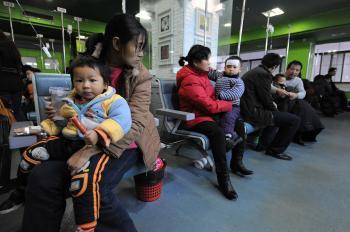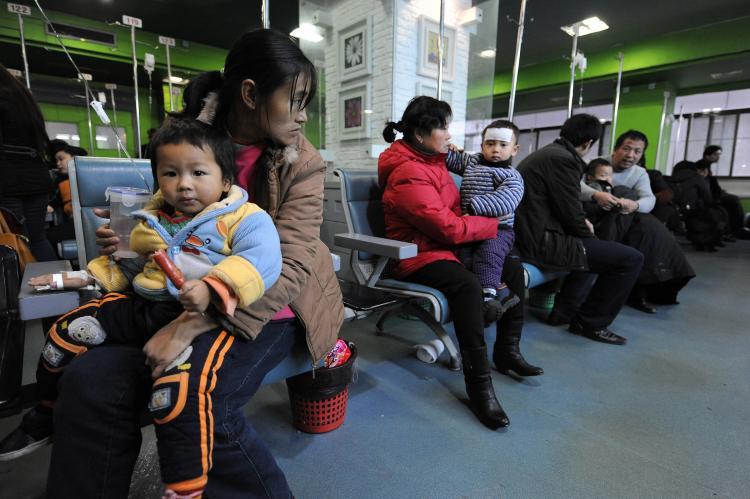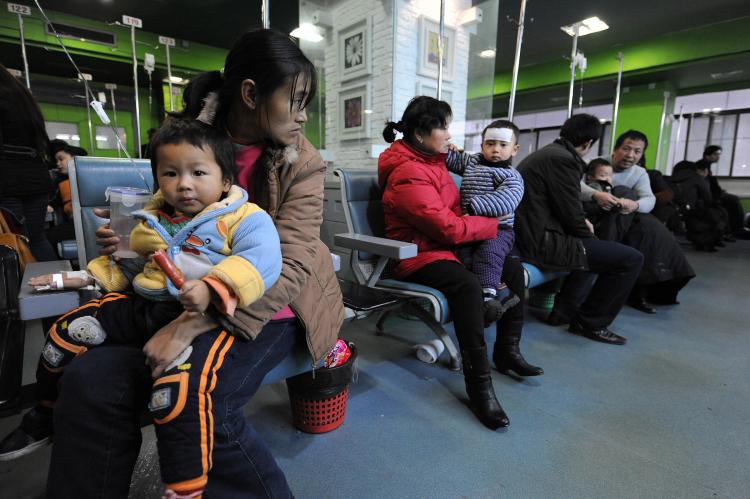Soon after the release of its investigation report of the H1N1 epidemic in Guangzhou, Southern China’s capital city, H1N1China.org released another survey report of the epidemic throughout China, which indicates that the Chinese communist regime is covering-up the epidemic.
The Web site conducted the survey from December 2009 to the end of January 2010. A total of 4,800 people have been interviewed by phone, and 95 confirmed H1N1 deaths have been reported.
The survey was conducted by randomly interviewing people by phone throughout China.
In order to estimate the base population, interviewees were asked about their social contacts. The results demonstrated that, on average, one person has social connection with about 200 other persons.
Using those numbers, the survey result from the 4,800 people could represent a survey from a base population of 1,000,000 people, or the equivalent to randomly sampling 1,000,000 persons.
The 95 confirmed H1N1 deaths equate to a mortality rate is 95 out of 1,000,000 or 0.000095.
With the Chinese population of 1.3 billion, the estimated H1N1 deaths throughout China based on the survey was 124,000 by the end of January 2010.
The estimated death toll is more than 160 times higher than the official death toll of 775 by the end of January 2010.
Currently, China’s state-run media seldom cover any news about the H1N1 pandemic. Experts have called on the Chinese to not let down their guard and take active measures [to avoid getting or spreading the flu].
Last month, a survey conducted by the same Web site on the H1N1 situation from Dec. 10 to 16, 2009, in Guangzhou City, indicated that the flu incidence rate there was about 26 percent of the population, which approximates the predicted rate from 15 to 20 percent by Guangdong’s Provincial Health Department.
According to the World Health Organization (WHO), the mortality rate among H1N1 patients is probably about 0.048 percent. That is, one patient may die per 2,000 infected persons. If, as of December 2009, the incidence rate in China reached 20 percent, the death toll would be 104,000 for the whole country. This estimation is also close to the survey results.
However, considering the poor medical conditions and the huge population, the death toll in China could be much higher.
The data collected from crematoriums also matched the survey results. According to data obtained by H1N1China.org, between July 2009 and December 2009, there were 178 confirmed H1N1 dead sent to Pingxiang Crematorium in Pingchuan, Baiyin City, of northwest China’s Gansu province.
According to official data, Baiyin City’s population is about 1.75 million, which gives the estimated mortality rate of 0.0001.
Taking China’s whole population as 1.3 billion, by end of December 2009, the estimated death toll for the nation would have been 132,000.
The survey report emphasizes that the above figure should be an underestimated value only because there are other crematoriums in Baiyin City.
Since the H1N1 outbreak, the Chinese regime has never published the H1N1 incidence rates and mortality rates, but just announced the deaths, which shows a far lower mortality rate comparing to other nations around the world.
According to a report released by U.S. Centers for Disease Control and Prevention (CDC), the centers estimate that between April 2009 and Jan. 16, 2010, about 400,000 to 800,000 people in the United States were infected by the H1N1 virus, and from 180,000 to 380,000 such patient were admitted to hospitals, and the estimated H1N1 deaths were from 8,330 to 17,160.
Considering the medical conditions in mainland China are far worse than the United States and the independent investigation team received many reports from mainland China that H1N1 patients died from a lack of timely medical treatment, [it is likely that the H1N1 death rate in China is higher than that in the United States].
Among the 17 confirmed H1N1 deaths listed in the H1N1 investigation report, four of them died from lack of timely medical treatment. The four victims were from Feitai in Beijing, Harbin in northeast China’s Helongjiang Province, Zhangjiajie in central China’s Hunan Province, and Quanzhou in southern China’s Fujian Province.
Among the four, the treatment of the two victims from Beijing and Fujian province had been delayed 10 days and one month, respectively.
It is reasonable to deduce that more such cases will surface if a full investigation is allowed. However, the deaths released by the Chinese regime are far less than other countries such as United States, and the regime has not yet provided a reasonable explanation for this discrepancy.
In a Sound of Hope interview, Dr Yan Jiaxin, a preventive medicine expert from Wuhan Institute of Biologic Products, said the official H1N1 death rates are “definitely underestimated.” Yan said the cover-up mislead the Chinese into believing that they had better immunity to the disease comparing to people in other countries.
Virology expert Dr. Hu Zongyi from the National Institutes of Health (NIH) in the United States said in an earlier interview with The Epoch Times, “It is very worrying—covering-up the epidemic would reduce people’s awareness of disease prevention. [It is] very dangerous.”
As early as November 2009, renowned Chinese professor Zhong Nanshan from the China Engineering Academy, publicly stated: “As for the number of H1N1 deaths reported in China, I don’t believe it at all!” Zhong is also the director of the Institute of Respiratory Disease, the First Affiliated Hospital of Guangzhou Medical College.
Dr. Zhong also stressed that the H1N1 virus may mutate or recombine with H5N1 virus, and the new strain would cause a much greater infection rate and death rate. Thus, it is critical to monitor the death rate worldwide in order to find out whether the virus has mutated. This requires transparency and honesty in H1N1 death rate monitoring and reporting.
Read the original Chinese article.
The Web site conducted the survey from December 2009 to the end of January 2010. A total of 4,800 people have been interviewed by phone, and 95 confirmed H1N1 deaths have been reported.
The survey was conducted by randomly interviewing people by phone throughout China.
In order to estimate the base population, interviewees were asked about their social contacts. The results demonstrated that, on average, one person has social connection with about 200 other persons.
Using those numbers, the survey result from the 4,800 people could represent a survey from a base population of 1,000,000 people, or the equivalent to randomly sampling 1,000,000 persons.
The 95 confirmed H1N1 deaths equate to a mortality rate is 95 out of 1,000,000 or 0.000095.
With the Chinese population of 1.3 billion, the estimated H1N1 deaths throughout China based on the survey was 124,000 by the end of January 2010.
The estimated death toll is more than 160 times higher than the official death toll of 775 by the end of January 2010.
Currently, China’s state-run media seldom cover any news about the H1N1 pandemic. Experts have called on the Chinese to not let down their guard and take active measures [to avoid getting or spreading the flu].
The Survey Results Approximates the Disease Incidence Rate
Last month, a survey conducted by the same Web site on the H1N1 situation from Dec. 10 to 16, 2009, in Guangzhou City, indicated that the flu incidence rate there was about 26 percent of the population, which approximates the predicted rate from 15 to 20 percent by Guangdong’s Provincial Health Department.
According to the World Health Organization (WHO), the mortality rate among H1N1 patients is probably about 0.048 percent. That is, one patient may die per 2,000 infected persons. If, as of December 2009, the incidence rate in China reached 20 percent, the death toll would be 104,000 for the whole country. This estimation is also close to the survey results.
However, considering the poor medical conditions and the huge population, the death toll in China could be much higher.
Data Collected From Crematoriums Match Survey Result
The data collected from crematoriums also matched the survey results. According to data obtained by H1N1China.org, between July 2009 and December 2009, there were 178 confirmed H1N1 dead sent to Pingxiang Crematorium in Pingchuan, Baiyin City, of northwest China’s Gansu province.
According to official data, Baiyin City’s population is about 1.75 million, which gives the estimated mortality rate of 0.0001.
Taking China’s whole population as 1.3 billion, by end of December 2009, the estimated death toll for the nation would have been 132,000.
The survey report emphasizes that the above figure should be an underestimated value only because there are other crematoriums in Baiyin City.
Since the H1N1 outbreak, the Chinese regime has never published the H1N1 incidence rates and mortality rates, but just announced the deaths, which shows a far lower mortality rate comparing to other nations around the world.
According to a report released by U.S. Centers for Disease Control and Prevention (CDC), the centers estimate that between April 2009 and Jan. 16, 2010, about 400,000 to 800,000 people in the United States were infected by the H1N1 virus, and from 180,000 to 380,000 such patient were admitted to hospitals, and the estimated H1N1 deaths were from 8,330 to 17,160.
Considering the medical conditions in mainland China are far worse than the United States and the independent investigation team received many reports from mainland China that H1N1 patients died from a lack of timely medical treatment, [it is likely that the H1N1 death rate in China is higher than that in the United States].
Among the 17 confirmed H1N1 deaths listed in the H1N1 investigation report, four of them died from lack of timely medical treatment. The four victims were from Feitai in Beijing, Harbin in northeast China’s Helongjiang Province, Zhangjiajie in central China’s Hunan Province, and Quanzhou in southern China’s Fujian Province.
Among the four, the treatment of the two victims from Beijing and Fujian province had been delayed 10 days and one month, respectively.
It is reasonable to deduce that more such cases will surface if a full investigation is allowed. However, the deaths released by the Chinese regime are far less than other countries such as United States, and the regime has not yet provided a reasonable explanation for this discrepancy.
The Regime’s Cover-Up Criticized by Both Chinese and Foreign Experts
In a Sound of Hope interview, Dr Yan Jiaxin, a preventive medicine expert from Wuhan Institute of Biologic Products, said the official H1N1 death rates are “definitely underestimated.” Yan said the cover-up mislead the Chinese into believing that they had better immunity to the disease comparing to people in other countries.
Virology expert Dr. Hu Zongyi from the National Institutes of Health (NIH) in the United States said in an earlier interview with The Epoch Times, “It is very worrying—covering-up the epidemic would reduce people’s awareness of disease prevention. [It is] very dangerous.”
As early as November 2009, renowned Chinese professor Zhong Nanshan from the China Engineering Academy, publicly stated: “As for the number of H1N1 deaths reported in China, I don’t believe it at all!” Zhong is also the director of the Institute of Respiratory Disease, the First Affiliated Hospital of Guangzhou Medical College.
Dr. Zhong also stressed that the H1N1 virus may mutate or recombine with H5N1 virus, and the new strain would cause a much greater infection rate and death rate. Thus, it is critical to monitor the death rate worldwide in order to find out whether the virus has mutated. This requires transparency and honesty in H1N1 death rate monitoring and reporting.
Read the original Chinese article.



Friends Read Free